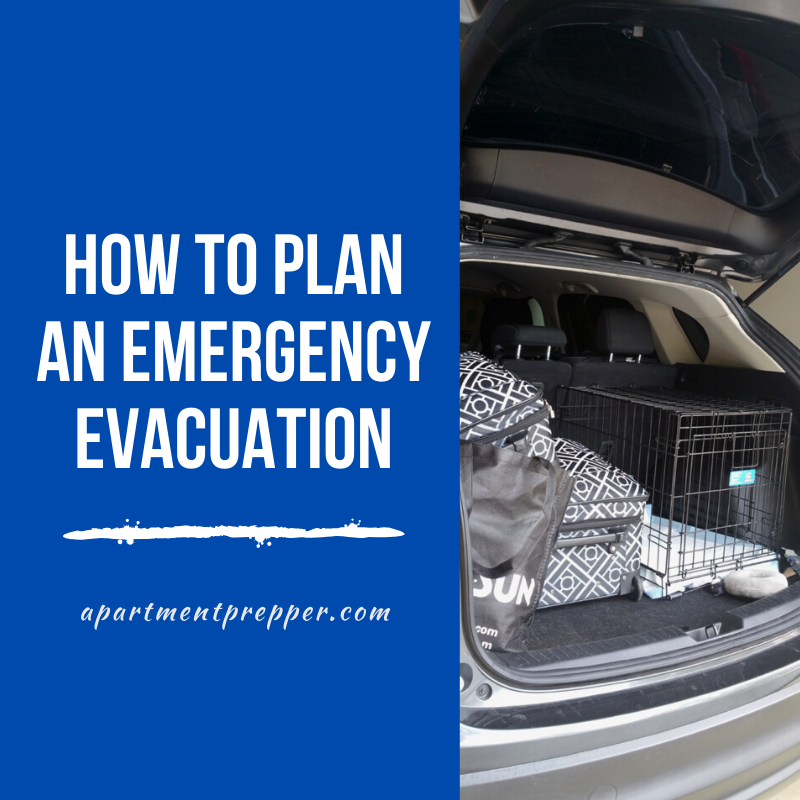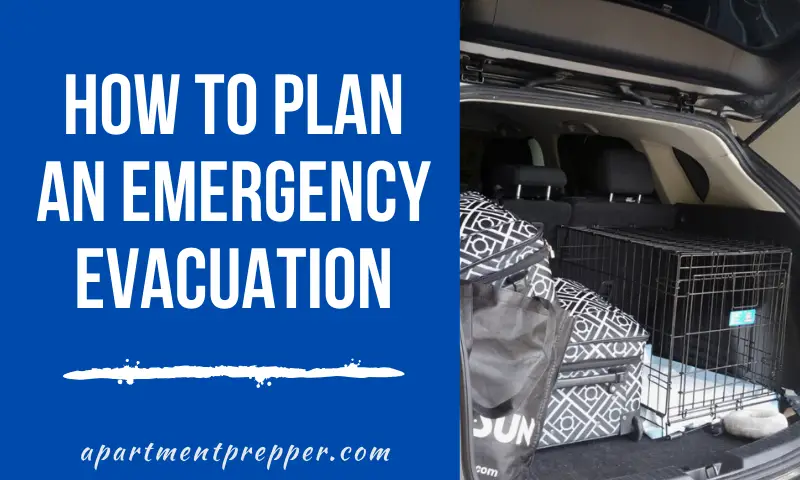This post is by Bernie Carr, apartmentprepper.com
Seeing riots and civil unrest unfold in many cities across the country shows us that areas can become unstable within a matter of hours. We also know that natural disasters can occur that may force us to evacuate our home even if we didn’t want to. In a previous post, we discussed tips on choosing a new apartment if you had to move right now. But what if you can’t move permanently at the moment, but need to evacuate for safety?
Think about what you would do right now if you had to evacuate within 30 minutes. Are you prepared for an emergency evacuation? Would you remember important things to take with you – your laptop? photos and mementos? cash? It would easy to panic and forget something you might regret later.
One size does not fit all
Each situation is different – you can evacuate just for a few days until things settle down, or it could be a long term evacuation where you don’t know when you will return. For this article, let’s consider it a temporary evacuation, where you can return to your home when the natural disaster or threat has passed.
Everyone’s evacuation is different, and each of us has to take decide what’s important.
Necessities
You’ll need to pack a 72 hour kit that covers basic needs for each member of the family.
Container
A good portable container is a backpack. The backpack should be of good quality, sturdy and as lightweight as possible. It should also fit comfortably to your size and body type. A good backpack will have a hip belt so most of weight sits on your hip and not your shoulders. It should have also have enough space, and reasonably priced. To avoid back strain, a rule of thumb is, a person should carry a pack weighing no more than 30% of his or her weight.
The backpack is not the only option. Some families choose other storage containers such as luggage or plastic bins. As long as you can easily grab it and fit it into your car, the choice is yours.
Clothes
Depending on the weather, you would want to dress appropriately and in layers if possible. You may start out walking in the cool morning air, but will eventually get hot as the day progresses. You will want to remove layers as you go.
Wool socks or synthetic fiber socks are better than cotton, as cotton retains moisture and will take a long time to dry if you sweat or get wet.
Synthetic fibers like fleece are good, as they draw moisture away from the skin. Pack enough clothes, socks and underwear for 72 hours.
Shoes
Hiking shoes are the best kind of shoes for walking long distances, and you will want to “break them in” before you have to bug out.
It is a good idea to carry moleskin pads which are self sticking cotton flannel pads to place over sensitive areas before blisters can develop.
You must take care of your feet, as they could potentially be your only transportation if your car breaks down.
Map and compass
Even if you have a GPS device, it is a good idea to keep a map and compass as backup, as there are certain areas where a GPS will not work well, such as valleys, or in bad weather.
First Aid Kit
You can assemble your own kit including pain reliever, anti-acid and diarrhea medicine, antibiotic cream for burns and insect bites, allergy medicine, wound care materials, etc. Or you can purchase a comprehensive pre-made kit such as this one.
In either case you should personalize your first aid kit according to your needs. Include your blood pressure medicines, asthma inhalers, diabetes supplies and extra prescriptions. Don’t forget face masks and disposable gloves, antibacterial gel and wipes.
Shelter
Emergency shelter is necessary in case you find yourself without accommodations. A lightweight tent would be ideal. f it is too bulky or heavy for one person, you can split and pieces among your group to spread out the weight, as long as you stay together. You would want a ground sheet inside your tent to keep water away from you.
Sleeping Bag
The sleeping bag should be lightweight and versatile for various types of weather, and go down to around 20 degrees if possible. Down is good and comfortable, but it must not get wet; while synthetic fill bags are not as comfy, but will dry well if the sleeping bag gets wet.
Water and Water Purifier
Always have extra water bottles on hand that you can take with you in an evacuation.
It’s a good idea to know several ways to purify water. I recently tested an easy to use water purifier. Of course a water purifier bottle is also a good one to have. I may also consider getting a Steri-pen which can purify with UV light, but you would still need to filter out pebbles and impurities with a cloth or bandanna before using.
Food
Dehydrated or freeze-dried food is highly recommended; as all you need to do is add hot water to the pack and you are done. But you can pack canned food or assemble your own ready to eat meals.
Don’t forget lightweight and portable cooking and eating utensils, as well as a can opener if you are relying on canned foods.
Stove and Fire starting materials
A means of cooking your food and boiling water are necessities. We have a propane camp stove, that has served us well in many emergencies.
Hygiene
Pack your sanitation and personal care items such as soap, toothbrush, toothpaste and other toiletries such as deodorant, sanitary napkins, etc.
Toilet paper is essential, but in an emergency, there are other choices. See our post on Toilet Paper Substitutes.
The Travel John works well for liquid waste, and you can also opt for a camp toilet.
Bring vomit bags in case someone gets car sick as well as extra trash bags.
Weapons
You will need to be able to protect yourself in a bug out situation. Guns, crossbows, slingshot, pepper spray–there is a variety of options and will vary according to your personal choice.
Pocketknife and Other Tools
We already keep a knife in the car as well as in our emergency bags. Other good tools include camp shovel, ax, saw, pick, machete, etc.
Communication
Depending on the emergency situation, your cell phone/ solar charger, crank radio will help you stay connected.
Other useful items that will make life bearable:
- Sunglasses, sunscreen, and wide-brimmed hat are all useful sun protection.
- Multi-towel – this is a nifty little towel that takes the place of several bath towels and will dry quickly. It is not absolutely necessary but nice to have if the budget allows.
- Headlamp – Easier than a flashlight, as you can keep your hands free to do other chores while in the dark.
- Insect repellent – this is a must have in the summer, especially if you live in an area with large bugs and mosquitoes. The brands with the most Deet are very effective, but must be used sparingly, as they are also corrosive and may be harmful. There are also natural alternatives such as lemon-eucalyptus herbal formulas, but may not be as effective as Deet.
- Rain gear such as jackets and ponchos; backpack cover since most backpacks are not waterproof
- Rope or paracord
- Deck of cards, books, small toys for the kids
This list does not cover absolutely everything needed to bug out; this is only a basic starter list.
Important documents
You’ll want to pack your laptop and emergency documents binder. Now is a good time to create your grab and go binder before anything happens.
Don’t forget your pets
If you have pets, your plan needs to include them. Pack your pet carrier, pet food, water/food dish, leash and any medications.
Cash
There is a chance credit and debit cards won’t work in a disaster, so always have emergency cash on hand so you can pay for gas, accommodations or food on the road.
Valuables
What are your most valued items – your Mom’s ring, wedding album, family photos, silver heirlooms? Make a list of items you cannot bear to leave and know where they are located if you had to leave in a hurry.
You may want to consider storing your photos in the cloud or in a portable hard drive so your don’t have to worry about photo albums.
Your vehicle
Your car should be in good working order. You’re also limited by how much you can carry so you will need to adjust accordingly. Make sure your car has gas, as well as other emergency items such as tire repair kit, spare tire, road flares, extra oil.
Make a checklist
One person should be in charge of calling out everything that needs to be done. It should include steps you and your family will take to get on the road.
- Get everyone dressed and ready to go.
- Get the pets in the car.
- Load up the car with your 72 hour emergency gear.
- Bring the cooler with ice, drinks and food.
- Unplug all the appliances in the house. Turn off gas and electricity if needed.
- Lock up all doors and windows.
- Close the garage door as you drive away.
These steps may seem self-explanatory but if you are in a panic mode, you may have difficulty remembering everything. You may not have the luxury of driving back to check if you accidentally left the garage door open. That’s why it’s good to have a checklist.
Do a drill
An evacuation is not an easy experience and getting all your family in sync can be a challenge. It can be very stressful. Practice your plan and see if you can get everyone out of the house in under 30 minutes. Many families already do a fire drill; why not add an evacuation drill and evaluate your results. What worked and what didn’t? You can refine your plan and feel confident your can evacuate to safety should the need ever arises.
**************************************************************************************
We are an affiliate of Amazon.com, which means we received a small commission if you click through one of our Amazon links when you shop, at totally no cost to you. This helps keep the lights on at the blog. Thanks!
About the author:
Bernie Carr is the founder of Apartment Prepper. She has written several books including the best-selling Prepper’s Pocket Guide, Jake and Miller’s Big Adventure, The Penny-Pinching Prepper and How to Prepare for Most Emergencies on a $50 a Month Budget. Her work appears in sites such as the Allstate Blog and Clark.com, as well as print magazines such as Backwoods Survival Guide and Prepper Survival Guide. She has been featured in national publications such as Fox Business and Popular Mechanics. Learn more about Bernie here.


